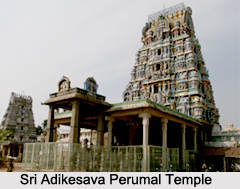 The tiny but ancient village of Kuram is situated about ten kilometers interior from the city of Kanchipuram. The small village of Kuram has been famous through the ages as it is the home to the famous temple dedicated to Lord Adikesava Perumal and as the birthplace of Kurattazhvan or Kuresha (1008-1127 A.D.), which was born in the asterism (nakshatram) Hastam in the Tamil month of Thai. Later became the famous disciple of the renowned Srivaishnava preceptor Sri Ramanujacharya.
The tiny but ancient village of Kuram is situated about ten kilometers interior from the city of Kanchipuram. The small village of Kuram has been famous through the ages as it is the home to the famous temple dedicated to Lord Adikesava Perumal and as the birthplace of Kurattazhvan or Kuresha (1008-1127 A.D.), which was born in the asterism (nakshatram) Hastam in the Tamil month of Thai. Later became the famous disciple of the renowned Srivaishnava preceptor Sri Ramanujacharya.
The temple dedicated to Lord Adikesava, facing to the eastward direction, is a small shrine. But the antiquity of this famous temple is revealed from the inscription stamped on the wall of the temple. The epigraphic evidences mention that this traditional shrine was in existence as early as the 9th century A.D. when the kings of the Pallava dynasty were ruling supreme in north Tamil Nadu. Under the patronage of the Pallavas the Lord Adikesava was in active worship, which was continued in the subsequent periods as well. The beautiful stone icon (moolavar)of the lord is the chief attraction of the temple. He is seen in a standing (sthanaka) posture with four arms (Chaturbhuja). He is seen here flanked by the deities like Sri Devi and Bhu Devi by His side. To the left of the main icon or the moolavar is erected a figure of lord Ananta or Adisesha. The beautiful utsava murtis are equally fascinating. These images of the Kuram temple are very similar to the main ones and beside them is seen an exquisite bronze image of Lord Krishna in a dancing pose. The arrangement of the deities in the pedestal and the moolavar and the utsava murtis collective cast a fascinating sight, which enraged the sense of veneration in the minds of the devotees.
Architecture of Sri Adikesava Perumal Temple, Kuram, South India: - the essence of Pallava art is reflected from the architectural style of Sri Adikesava Perumal Temple. The structural design of the temple and the proper arrangement of the deities in their respective pedestal reveal the architectural excellence of the contemporary artists.
Inscription of Sri Adikesava Perumal Temple, Kuram, South India: - The inscriptions on the temple points to the chronology of the temple. The epigraphic evidences point to the administrative system of the Pallava kings. The village administration is also revealed from the inscriptions of the Pallavas.
Festivals of Sri Adikesava Perumal Temple, Kuram, South India:-A large number of festivals are celebrated in the Adikesava Perumal temple annually. The festivals are observed with immense pomp and grandeur. During the festival season a large number of devotees gather in the temple premises in order to offer their worship and veneration to the Lord. The most important of these is the Brahmotsavam in the month of Thai (January-February) and the special festival for Kurattazhvan is observed during Hastam nakshatram, his birth asterism in Thai. Every month, tirumanjanam is performed on Hasta nakshatram during the afternoons. Several other significant festivals like Panguni Uttiram, Rama Navami, Krishna Jayanthi (with Uriadi in the evenings), Deepavali and a host of other celebrations usually associated with Srivaishnava shrines, which reveal the cultural significance of the temple.





















